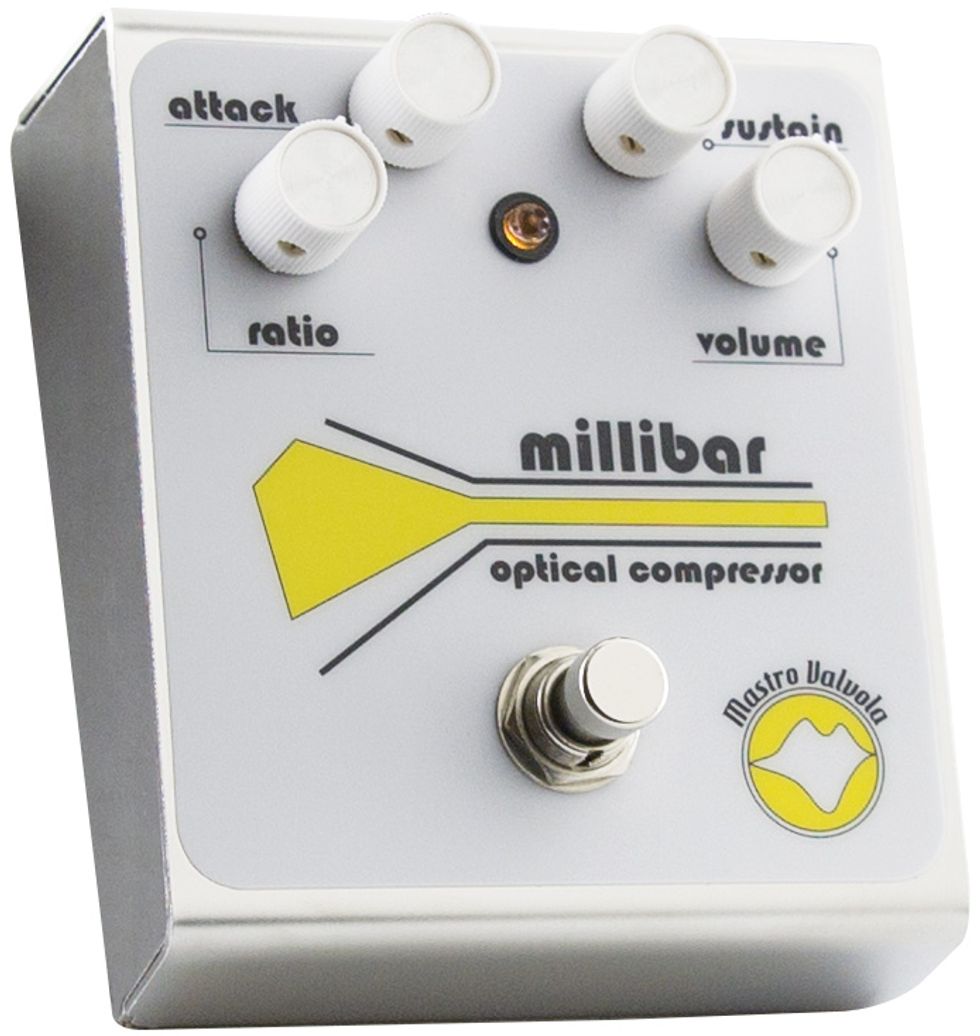Drawing inspiration from Universal Audio’s famous 1176 and Teletronix’s LA-2A, Mastro Valvola’s Millibar is an optical compressor with an exceptional range of control. And like the studio compressors that inspired it, it’s a highly functional unit with the ability to enliven lifeless tones, re-shape a guitar’s voice to fit in a mix, and focus squirrelly overdriven signals.
Futurist Design
The Millibar’s cool aesthetic—one that crosses the easy-to-read control panels of medical equipment with a colorful ’70s graphic style—works well in practical and aesthetic terms. The folded steel enclosure is sturdy and easy to open. The four knobs make up a familiar and common compressor control set. Attack changes the speed with which the compression affects the signal. Sustain can be increased with a clockwise turn.
for little amps.
Ratio sets the level of compression, while volume sets the overall output. The Millibar ships with a 9V battery that can be accessed by removing the four plate screws on the bottom of the housing. You can also power the pedal via a 9V DC jack. The guts of the compressor are mounted on a couple PCBs and it’s very well put together.
Wrangling the Highs and Lows
By using the Millibar with Fender single-coils and a Fender Champ 600—a setup with relatively thin-sounding output—I got a grip on how much meat the Millibar can add to a tone recipe. Setting all the controls in the 12 o’clock range added the extra body that made full-step bends float and fade with more sustain, and made the little Champion sound much larger in tracking situations. It’s easy to imagine the Millibar working wonders in studios for little amps.
Ratings
Pros:
Great range of control. Highly versatile. Cool aesthetic design.
Cons:
Slightly expensive.
Tones:
Ease of Use:
Build/Design:
Value:
Street:
$217
Mastro Valvola Millibar
mastrovalvola.it
The expressive range gets wider still through a big rig—in this case an Orange OR50 and Fender Stratocaster. It was hard not to resist playing like David Gilmour circa The Wall, given all the squish and sustain. Crafty use of the volume control is paramount with big amps (which are typically used in band settings) and high compression ratios. Fat compression usually means a perceived volume drop, and by adding extra volume, you can really squeeze your output with a heavy ratio and still make it out above the hum of a band.
With a Gibson Les Paul, I found (not unexpectedly) that I needed considerably less sustain compared to single-coils. I rarely add extra compression to PAF-style humbuckers in a live setting. But the Millibar added plenty of cool, subtle enhancements to my humbucker output. By turning down the ratio and sustain and keeping the attack around noon, humbuckers took on a nice bit of extra contour that massaged pick attack without neutering it.
Millibar also excels when adding additional effects. While an EarthQuaker Devices Hoof doesn’t need any help in the sustain department, a little extra attack from the Millibar and a subtly higher compression ratio can create a more focused fuzz lead tone. Similarly, the swirling waves of a Homebrew Electronics Psilocybe phaser were significantly augmented with the Millibar out front, with undulations becoming more pronounced as I increased ratio and sustain.
The Verdict
Compressors aren’t the most dazzling effect, but they can transform your tone in beautiful and very utilitarian ways. The Mastro Valvola Millibar performs these fundamental compression tasks in exemplary style. And whether subtly reshaping tone or squeezing every last bit of your output, it remains very musical. I would recommend it for both live and studio settings.








![Rig Rundown: Russian Circles’ Mike Sullivan [2025]](https://www.premierguitar.com/media-library/youtube.jpg?id=62303631&width=1245&height=700&quality=70&coordinates=0%2C0%2C0%2C0)

















